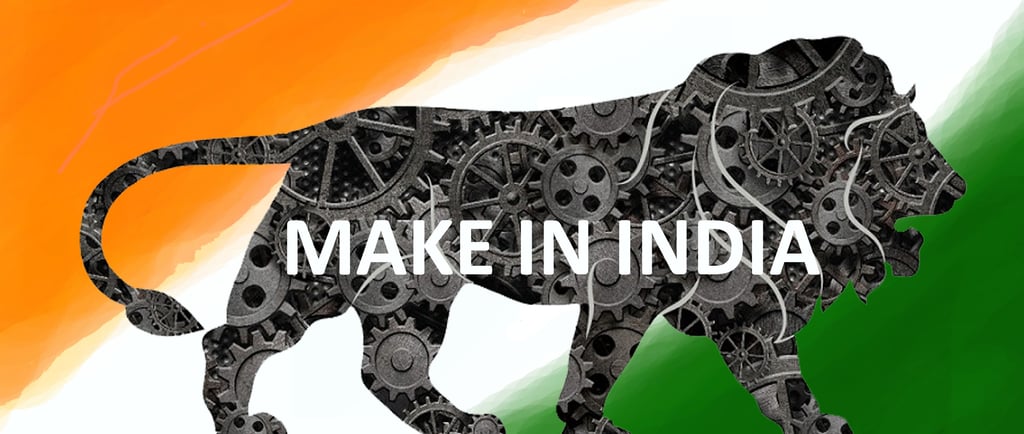Make in India 2025: A Deep Dive into the National Manufacturing Mission & Future Outlook
The Make in India initiative has been supercharged for 2025. This in-depth guide explores the new National Manufacturing Mission, expanded PLI schemes covering 27 sectors, and the profound economic impact on job creation, exports, and GDP. Discover why India is now a premier global manufacturing destination and what it means for investors, businesses, and the workforce.
CURRENT NEWS


Launched in 2014, the Make in India initiative has been the cornerstone of India's ambitious economic transformation. As we move into 2025, the program has not just evolved; it has been radically accelerated by a wave of strategic policy reforms and monumental investments. The centerpiece of this new phase is the National Manufacturing Mission, announced in the groundbreaking 2025-26 Union Budget.
This isn't just policy—it's a national blueprint for positioning India as a global manufacturing hub, reducing import dependency, and creating sustainable growth for decades to come. This article provides a comprehensive analysis of what's new, why it matters, and what the future holds.
Part 1: The 2025 Policy Revolution - A Strategic Overhaul
The Indian government has moved from broad encouragement to targeted, sector-specific strategy. The policies for 2025 are characterized by depth, clarity, and overwhelming financial backing.
1. The National Manufacturing Mission: A Game Changer
The announcement of the National Manufacturing Mission marks a significant shift from a broad-based initiative to a focused, outcomes-driven campaign.
Strategic Sectors: The mission explicitly targets high-growth, future-oriented sectors critical for national and global demand:
Clean Tech: Manufacturing of solar panels, wind turbines, and green hydrogen equipment.
Advanced Electronics: Focus on semiconductor fabrication (fabs), display panels, and PCB assembly.
EV Batteries & High-Voltage Equipment: Creating a full domestic supply chain for electric vehicles and grid modernization.
Beyond Financial Incentives: While funding is key, the mission provides what industry truly needs: policy stability, clear 5-10 year roadmaps, and streamlined regulatory frameworks. This reduces uncertainty for both domestic and foreign investors looking to make billion-dollar, long-term bets.
2. Production-Linked Incentives (PLI): The Engine of Growth
The PLI scheme is arguably the most successful component of Make in India, and its scope and scale have expanded dramatically.
The Numbers: With an outlay of ₹1.97 lakh crore (approx. $26 billion) across 14 key sectors, the PLI scheme directly rewards companies for achieving incremental production and sales targets. This results-oriented approach ensures taxpayer money delivers tangible output.
Key Sectors Benefiting:
Electronics Manufacturing: Mobile phone production has skyrocketed, making India the second-largest mobile manufacturer globally.
Pharmaceuticals: Incentivizing the production of complex generic drugs, APIs (Active Pharmaceutical Ingredients), and medical devices to make India the "pharmacy of the world."
White Goods (ACs, LEDs): Boosting domestic manufacturing of components to complete the ecosystem.
Impact: The PLI scheme is projected to add over $500 billion to India’s GDP in the next five years and generate millions of new jobs.
3. Expanding the Horizon: 27 Sectors of Opportunity
Make in India's scope now encompasses 27 diverse sectors, from traditional strengths like textiles and automobiles to sunrise sectors like drones, robotics, and renewable energy. This diversification de-risks the national economy and creates a holistic industrial ecosystem where sectors synergize and support each other.
Part 2: The Foundational Pillars of Success
The high-level missions and schemes are supported by robust foundational reforms that make doing business in India easier than ever before.
1. Empowering the Backbone: MSME Support
Micro, Small, and Medium Enterprises (MSMEs) are the lifeblood of the Indian economy, contributing over 30% to the GDP and employing over 110 million people. Recent enhancements include:
Collateral-Free Loans: Schemes like the Credit Guarantee Fund Trust for Micro and Small Enterprises (CGTMSE) have been expanded, enabling easier access to capital.
Formalization and Technology Adoption: Initiatives like the Udyam Portal simplify registration, while programs encourage MSMEs to adopt digital tools and e-commerce platforms to compete globally.
2. Radical Simplification: Ease of Doing Business 2.0
India's dramatic rise in the World Bank's Ease of Doing Business rankings was just the beginning. Ongoing efforts include:
Single-Window Clearance: A centralized portal for all business-related approvals and compliances.
Drastic Reduction in Compliance Burden: Decriminalization of minor business laws, self-attestation of documents, and digitalization of processes have significantly reduced the time and cost of operations.
Attracting Foreign Direct Investment (FDI): Liberalized FDI norms across sectors, including defense and insurance, have led to record-breaking inflows, cementing global confidence in the Indian economy.
Part 3: The Macro-Economic Impact - Why Make in India is Crucial
The initiative's importance extends far beyond factory floors. It is a multi-faceted strategy for national development.
1. Job Creation for a Young Nation
With over 65% of its population under 35, India needs to create 10-12 million new jobs annually. Manufacturing is one of the largest employment multipliers. A single job in a core manufacturing unit can create 3-4 ancillary jobs in the supply chain, logistics, and services, empowering millions and boosting domestic consumption.
2. The Atmanirbhar Bharat (Self-Reliant India) Effect
A primary goal is to reduce India's vulnerability to global supply chain disruptions, as witnessed during the pandemic.
Boosts Exports: By manufacturing quality goods competitively, Indian companies are expanding their global footprint.
Reduces Imports: Domestic production in electronics, defense, and energy equipment saves billions of dollars in foreign exchange, strengthening the rupee and the national economy.
3. Building a Skilled & Innovative Nation
Make in India works in tandem with the Skill India Mission to create a future-ready workforce. Industry-linked training programs are developing a pool of highly skilled technicians, engineers, and managers proficient in Industry 4.0 technologies like AI, IoT, and automation.
4. World-Class Infrastructure Development
Growth is supported by massive investments in infrastructure:
Industrial Corridors: Delhi-Mumbai Industrial Corridor (DMIC), Chennai-Bengaluru Industrial Corridor (CBIC).
Logistics: The National Logistics Policy aims to reduce high logistics costs from 14% to 8% of GDP, making Indian goods more competitive.
Smart Cities: Developing integrated cities with modern amenities to attract top talent.
Part 4: The Road Ahead - Sustainability and Global Leadership
The future of Make in India is digital, green, and inclusive.
Digital Manufacturing: The adoption of smart factories, AI-driven quality control, and digital twins will define the next decade of production.
Focus on Sustainability: The 2025 mission heavily emphasizes green manufacturing. Incentives are aligned with achieving net-zero goals by 2070, promoting circular economy principles, and using renewable energy in industrial processes.
Inclusive Growth: The latest policies ensure the benefits of growth reach women entrepreneurs, rural enterprises, and marginalized communities, fostering balanced and sustainable development.
